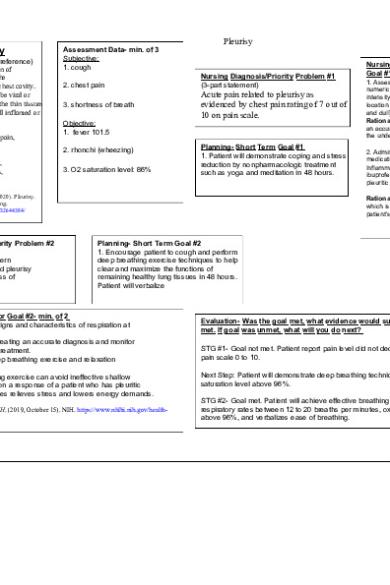Nursing Concept map for pain-Pleurisy-Map PDF

| Title | Nursing Concept map for pain-Pleurisy-Map |
|---|---|
| Author | oanh vo |
| Course | Fundmentals |
| Institution | Arizona College of Nursing |
| Pages | 1 |
| File Size | 115.1 KB |
| File Type | |
| Total Downloads | 45 |
| Total Views | 178 |
Summary
Bacteria Pneumonia for Foundational of Nursing NUR 215....
Description
Pathophysiology (In your own words-cite reference) Pleurisy is an inflammation of the membranes covering the lung and the lining of the chest cavity. The cause of pleurisy can be viral or bacterial infection causes the thin tissues line the lung and chest wall inflamed or infected. Clin. Mani: fever, cough, Shortness of breath, chest pain, Headaches Causative Org: influenza, respiratory, syncytial virus, parainfluenza
Assessment Data- min. of 3 Subjective: 1. cough 2. chest pain 3. shortness of breath
Pleurisy
Nursing Diagnosis/Priority Problem #1 (3-part statement)
Acute pain related to pleurisy as evidenced by chest pain rating of 7 out of 10 on pain scale.
Objective: 1. fever 101.5 2. rhonchi (wheezing) 3. O2 saturation level: 86%
Planning- Short Term Goal #1 1. Patient will demonstrate coping and stress reduction by nonpharmacologic treatment such as yoga and meditation in 48 hours.
Hunter, M. P., & Regunath, H. (2020). Pleurisy. In StatPearls. StatPearls Publishing. https://pubmed.ncbi.nlm.nih.gov/32644384/
Nursing Diagnosis/Priority Problem #2 (3-part statement) Ineffective breathing pattern related to bacteria caused pleurisy as evidenced by shortness of breath and cough.
Nursing Interventions for Goal #1- min. of 2 1. Assess the patient using a numeric pain rating scale for intensity, also characteristics and location of pain (crushing, sharp, and dull). Rationale: To assist in creating an accurate diagnosis and treating the underlying cause of pain. 2. Administer the prescribed antibiotic medication: non-steroidal antiInflammatory drugs (NSAIDS) such as ibuprofen are effective to relieve pleuritic pain. Rationale: To treat bacterial infection which is the underlying cause of patient’s pleurisy.
Planning- Short Term Goal #2 1. Encourage patient to cough and perform deep breathing exercise techniques to help clear and maximize the functions of remaining healthy lung tissues in 48 hours. Patient will verbalize
Nursing Interventions for Goal #2- min. of 2 1. Assess patient’s vital signs and characteristics of respiration at least every 4 hours. Rationale: To assist in creating an accurate diagnosis and monitor effectiveness of medical treatment. 2. Educate patient on deep breathing exercise and relaxation techniques. Rationale: Deep breathing exercise can avoid ineffective shallow breathing which is common a response of a patient who has pleuritic pain. Relaxation techniques relieves stress and lowers energy demands. Pleural Disorders | NHLBI, NIH. (2019, October 15). NIH. https://www.nhlbi.nih.gov/healthtopics/pleural-disorders
Evaluation- Was the goal met, what evidence would support the goal being met. If goal was unmet, what will you do next? STG #1- Goal not met. Patient report pain level did not decrease when using the pain scale 0 to 10. Next Step: Patient will demonstrate deep breathing techniques to optimal O2 saturation level above 96%. STG #2- Goal met. Patient will achieve effective breathing pattern as evidence by respiratory rates between 12 to 20 breaths per minutes, oxygen saturation of above 96%, and verbalizes ease of breathing....
Similar Free PDFs

Nursing Concept Map
- 2 Pages

Nursing Concept Map Medsurg 2
- 2 Pages

Nursing Concept Map Template VBC
- 1 Pages

Concept map for Osteosarcoma
- 2 Pages

Risk for Aspiration Concept Map
- 2 Pages

Concept map for danielle bear
- 2 Pages

Concept Map
- 1 Pages

Concept map
- 2 Pages
Popular Institutions
- Tinajero National High School - Annex
- Politeknik Caltex Riau
- Yokohama City University
- SGT University
- University of Al-Qadisiyah
- Divine Word College of Vigan
- Techniek College Rotterdam
- Universidade de Santiago
- Universiti Teknologi MARA Cawangan Johor Kampus Pasir Gudang
- Poltekkes Kemenkes Yogyakarta
- Baguio City National High School
- Colegio san marcos
- preparatoria uno
- Centro de Bachillerato Tecnológico Industrial y de Servicios No. 107
- Dalian Maritime University
- Quang Trung Secondary School
- Colegio Tecnológico en Informática
- Corporación Regional de Educación Superior
- Grupo CEDVA
- Dar Al Uloom University
- Centro de Estudios Preuniversitarios de la Universidad Nacional de Ingeniería
- 上智大学
- Aakash International School, Nuna Majara
- San Felipe Neri Catholic School
- Kang Chiao International School - New Taipei City
- Misamis Occidental National High School
- Institución Educativa Escuela Normal Juan Ladrilleros
- Kolehiyo ng Pantukan
- Batanes State College
- Instituto Continental
- Sekolah Menengah Kejuruan Kesehatan Kaltara (Tarakan)
- Colegio de La Inmaculada Concepcion - Cebu







